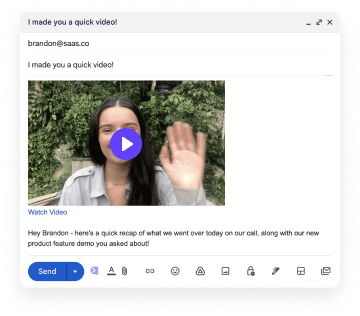How much time is your sales team spending selling? You may be quick to say they spend the whole workday selling. It is in their job title, after all.
But studies suggest the average salesperson spends only 35 percent of their day selling prospects. Assuming your salesperson works about eight hours daily, that’s less than three hours. Breaking down the average day of a salesperson, you may find your team is selling for even fewer hours than those three.
Why is a salesperson doing so little in sales? First, the job name is a bit of a misnomer because you couldn’t fit everything they do in their job title. In reality, a salesperson is a researcher, a consultant, a content creator, and even an actor.
ChatGPT and other artificial intelligence (AI) platforms can help reduce the roles a salesperson has to play, making more time for the selling portion of their jobs.
Let’s get into what ChatGPT can do for sales.
1. Research your audience.
A study that surveyed over 700 sales reps found that the average salesperson spends 11.6 percent of their day researching. Researching is a vital part of the sales process. While some other teams, like marketing, may assist with lead generation, it’s often on the salesperson to find and vet their leads.
ChatGPT works as an AI chatbot. While you can generate text with it, it also functions as a research tool. OpenAI fed ChatGPT 570 GB of data from books, articles, and other writing pieces. In total, the company provided the chatbot with 300 billion words.
You can ask ChatGPT any questions and receive the best answer the chatbot can give you with this information. ChatGPT is a great starting place for research, although you shouldn’t rely on it as your only research tool. It is not connected to the internet and has limited world knowledge after 2021. You may need to do additional research if you need more up-to-date information.
ChatGPT also occasionally comes up with what OpenAI calls “hallucinations.” When ChatGPT “hallucinates,” it comes up with a nonsensical answer to a question or objectively incorrect answers.
These answers are not factual and sometimes based on harmful stereotypes. However, OpenAI claims that “hallucinations” have been significantly reduced in their newest ChatGPT model, GPT-4.
You should still always vet your research from ChatGPT before taking it as fact.
2. Gather information for competitive analysis.
Part of sales is knowing how to sell against your biggest competitors. Just like ChatGPT can do preliminary research on your potential prospects, the chatbot can help you acquire competitor data.
Essentially, you’ll have a conversation with ChatGPT, treating the chatbot as the expert. Ask questions like who the most significant companies are in your market, what content is doing well on a competitor’s website, their greatest strength, and where their weaknesses lie.
Gathering data through ChatGPT helps reduce the risk of data silos.
Data must be able to move throughout your team. Too often, one person does extensive research that stays buried in their head and personal documents. Using ChatGPT for competitor analysis, you can export your previous conversations with the chatbot.
Once you export this data, you can easily disseminate it amongst your team or keep it in a public file for frequent reference.
2. Generate templates for cold sales emails.
According to McKinsey & Company’s analysis, the average worker in the United States spends 28 percent of their day reading and answering emails. This number likely increases for salespeople, who spend a significant portion of their day doing cold emailing.
While cold emails should always include personalization and fit your company’s brand voice, developing templates to make these steps more manageable rather than writing every email from scratch is helpful. Save even more time by having ChatGPT write the templates for you. Using this method, you could have the application write various templates to reach different types of prospects.
To ensure you’re getting the most out of your emailing efforts, use ChatGPT with other web applications built to help your emails get opened and read. While ChatGPT can help you create what you want to say, other applications can help manage your email list and ensure you follow all necessary guidelines to prevent your email from landing in the dreaded junk mail folder.
By relying on this technology, you can significantly reduce your time focused on email while optimizing your messages for a better open rate.
3. Build the framework for a video script.
As we’ve seen from the transition from more photo-based social media apps moving toward more video content, video is becoming a big part of our daily lives. But the movement for more video content goes beyond the growth of TikTok and Instagram Reels.
Video is also becoming more common in our daily professional lives. Some apps let you make videos quickly to explain a process to a coworker, some make video email signatures, and others help you send outreach videos while generating leads on LinkedIn. The possibilities with video are endless. But first, you need to make a video that grabs attention.
In a survey on the state of video marketing, 78 percent of those surveyed said that video directly increased sales. Before making a video that leads to sales, you need to write a script. While you’ll want to personalize the video and ensure it fits your company’s brand voice, ChatGPT can help you build the framework.
Sendspark has a video script generator built on ChatGPT that lets us create scripts tailored to your prospects based on your use case and relationship with them.
4. Automatically Personalize Videos at Scale
You can use AI to automatically personalize videos for each of your viewers, with a greeting like "Hi [Name]."
This can save you hours from recording personalized videos for each prospect manually, and still help you see 20%+ more email engagement than with plain text emails.
5. Role play calls with a prospect.
You may have seen videos of ChatGPT roleplaying with a user by now. In addition, some people use the chatbot for interactive games or teaching tools. This feature of ChatGPT even supports a new version of Duolingo where you can roleplay real-life conversations in the language you’re attempting to learn.
Roleplay isn’t all just fun and games, though. This ChatGPT feature can also be helpful when attempting to predict how a sales call may go. Suggest that ChatGPT plays a specific role.
If you’re trying to sell software for social media analytics, suggest ChatGPT play a social media manager. You can even add certain parameters like this social media manager doesn’t have a large team or a small budget.
The more information you can give ChatGPT, the more realistically the conversation will flow. Although all prospect calls aren’t entirely predictable, using ChatGPT this way can boost your salespeople’s confidence and make them feel more prepared when speaking with real potential customers.
Wrapping Up What ChatGPT Can Do for Sales
Salespeople spend less of their day selling than you may think. Much of this has to do with them having to perform the same time-consuming tasks daily. AI, like ChatGPT, can reduce the time spent on such processes and allow them to spend more of their day selling.
ChatGPT offers a wealth of knowledge at your fingertips, which you can use to research prospects and competitors. But it’s also a writing tool that can help you send emails more efficiently and make videos that result in sales. As a chatbot, it also offers a roleplaying tool that can better help your team prepare for prospect calls.
AI can make your sales team more efficient. Soon enough, you’ll have ChatGPT to thank for why your team is reaching and exceeding quotas quarter after quarter.



